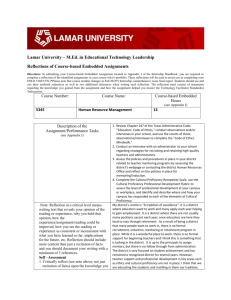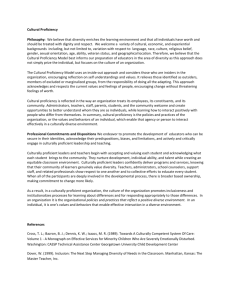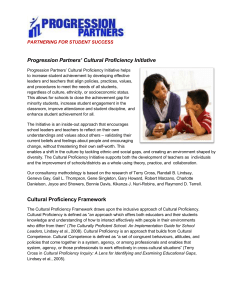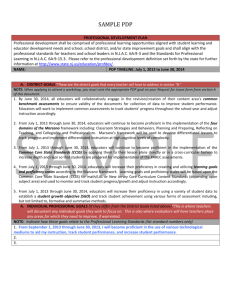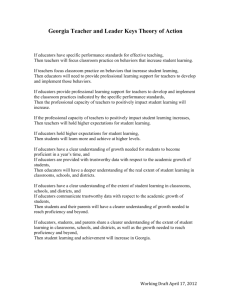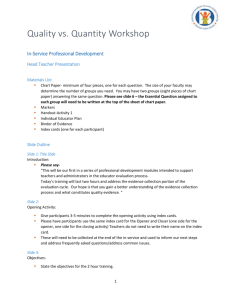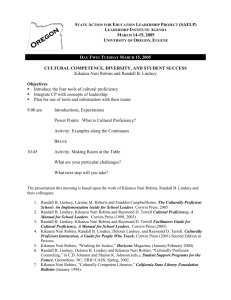Cultural proficiency: Changing the conversation
advertisement
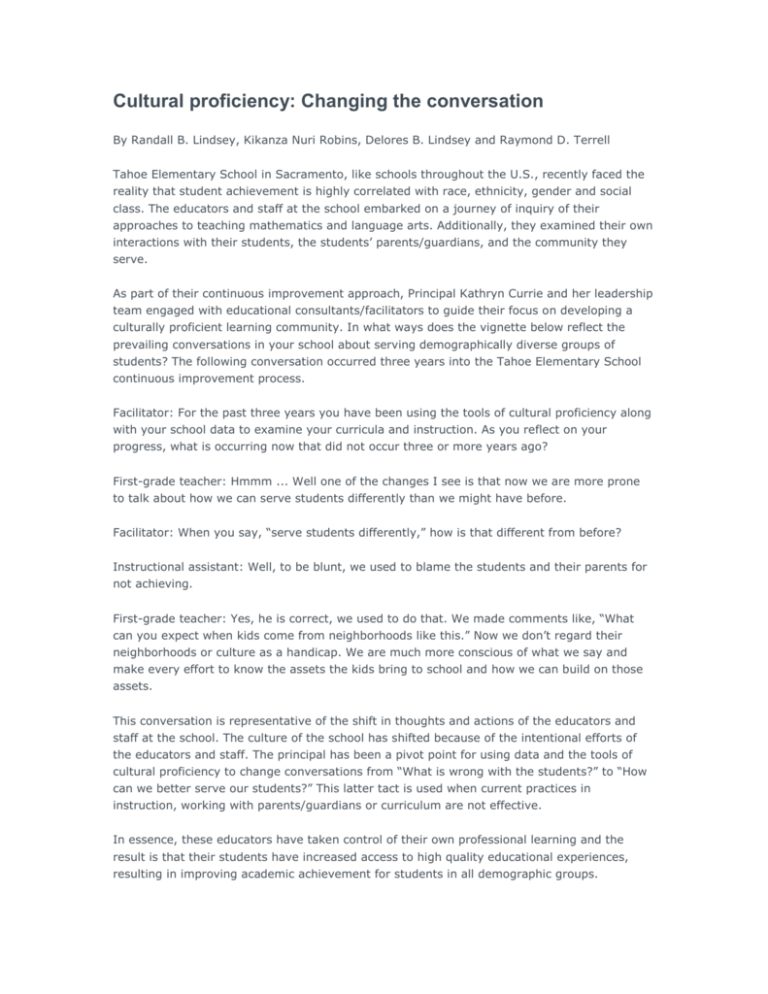
Cultural proficiency: Changing the conversation By Randall B. Lindsey, Kikanza Nuri Robins, Delores B. Lindsey and Raymond D. Terrell Tahoe Elementary School in Sacramento, like schools throughout the U.S., recently faced the reality that student achievement is highly correlated with race, ethnicity, gender and social class. The educators and staff at the school embarked on a journey of inquiry of their approaches to teaching mathematics and language arts. Additionally, they examined their own interactions with their students, the students’ parents/guardians, and the community they serve. As part of their continuous improvement approach, Principal Kathryn Currie and her leadership team engaged with educational consultants/facilitators to guide their focus on developing a culturally proficient learning community. In what ways does the vignette below reflect the prevailing conversations in your school about serving demographically diverse groups of students? The following conversation occurred three years into the Tahoe Elementary School continuous improvement process. Facilitator: For the past three years you have been using the tools of cultural proficiency along with your school data to examine your curricula and instruction. As you reflect on your progress, what is occurring now that did not occur three or more years ago? First-grade teacher: Hmmm ... Well one of the changes I see is that now we are more prone to talk about how we can serve students differently than we might have before. Facilitator: When you say, “serve students differently,” how is that different from before? Instructional assistant: Well, to be blunt, we used to blame the students and their parents for not achieving. First-grade teacher: Yes, he is correct, we used to do that. We made comments like, “What can you expect when kids come from neighborhoods like this.” Now we don’t regard their neighborhoods or culture as a handicap. We are much more conscious of what we say and make every effort to know the assets the kids bring to school and how we can build on those assets. This conversation is representative of the shift in thoughts and actions of the educators and staff at the school. The culture of the school has shifted because of the intentional efforts of the educators and staff. The principal has been a pivot point for using data and the tools of cultural proficiency to change conversations from “What is wrong with the students?” to “How can we better serve our students?” This latter tact is used when current practices in instruction, working with parents/guardians or curriculum are not effective. In essence, these educators have taken control of their own professional learning and the result is that their students have increased access to high quality educational experiences, resulting in improving academic achievement for students in all demographic groups. Cultural proficiency as an educational leadership lens Culturally proficient educational leaders are effective in cross-cultural situations that affect their students, the communities they serve, and the educators and staff members in their schools. Culturally proficient educational leaders are committed to educating all students to high levels through knowing, valuing and using the students’ cultural backgrounds, languages and learning styles within the selected curricular and instructional contexts. Leaders who are committed to leading our schools in a way that all students have access to the benefits of a democratic system can use the tools of cultural proficiency as a template for their personal and professional development. The tools of cultural proficiency provide us with: • Guiding principles on which to build an ethical and professional frame for effective crosscultural communication and problem-solving; • A continuum of behaviors that enable us to diagnose our values and behavior in such a way that we can better influence the policies and practices of our profession; • Essential elements expressed in terms of standards of personal and professional conduct that serve as a framework for intentionally responding to the academic and social needs of the cultural groups in our school and community; and • Barriers that serve as caveats to the use of the guiding principles and essential elements. The cultural proficiency toolkit Cultural proficiency comprises an interrelated set of tools that pose significant questions to prompt reflection and the opportunity to improve our leadership practice in service of others: • Are we who we say we are? • How do we assess who we are? • Do our actions align with who we say we are? • What gets in our way of being who we say we are? The tools provide us with the means by which to lead our personal lives and perform our professional responsibilities in a culturally proficient manner. Cultural proficiency represents a leadership paradigm Cultural proficiency is a mindset for how we interact with all people, irrespective of their cultural memberships. Cultural proficiency is a worldview that carries explicit values, language and standards for effective personal interactions and professional practices. Cultural proficiency is a 24/7 approach to our personal and professional lives. Most importantly, cultural proficiency is not a set of independent activities or strategies that we learn to use with others – our students, colleagues or community members. A conversation gap Too often, educators and educational policy makers experience a conversation gap when focusing on the achievement issues of students that are based in students’ cultural differences. The gap in conversation, which is often unrecognized and unacknowledged, is educators not having the perspective to see systemic roadblocks that have been, and are, impeding the academic success of socio-economic, racial, ethnic, gender or language groups of our students. This selective invisibility leads to a sense of privilege and entitlement for educators. While systems of oppression impose barriers for members of cultural groups, concomitant systems of privilege and entitlement impose barriers for educators. The barriers erected by a sense of privilege and entitlement involve a skewed sense of reality that impedes one’s ability to pursue ethical and moral avenues in meeting the academic and social needs of cultural groups of students. The position of privilege often fosters educators voicing biased or ill-informed assumptions about parents from some cultural groups. Typical of such assumptions are comments such as: “Their parents won’t come to parent conferences because they don’t care about the education of their child.” “Why try to help them. They will just end up as gang-bangers, just like their dad!” “Why should I learn anything about their culture? This is our country, let them learn about us!” Educators who make comments like these are in need of different lenses, tools and structures to understand the obstacles their students face and their learning needs for success in school. As a leader, when you are aware of these barriers and needs you can use the guiding principles, the continuum, and the essential elements to frame conversations with fellow educators about how parents and students who are culturally different from you behave and learn. Cultural proficiency is an approach for surfacing educators’ assumptions and values that undermine the success of some student groups, and a lens for examining how we include and honor the cultures and educational strengths and needs of all students in the educational process. The educators at Tahoe Elementary School are well on their way to becoming a culturally proficient learning community. The school has moved its API score from 556 to 765 and exited Program Improvement last year, much to the delight of the educators and parents/guardians in the school community. References Collins, Jim. (2001). Good to great. New York: Harper Collins. Lindsey, Randall B.; Nuri Robins, Kikanza & Terrell, Raymond D. (2009). Cultural Proficiency: A Manual for School Leaders (3rd Edition), Thousand Oaks, CA: Corwin Press. Perie, Marianne; Moran, Rebecca & Lutkus, Anthony D. (2005). NAEP 2004 trends in academic progress: Three decades of student performance in reading and mathematics (NCES 2005464). U.S. Department of Education, Institute of Education Sciences, National Center for Education Statistics. Washington, D.C.: Government Printing Office. Terrell, Raymond D. & Lindsey, Randall B. (2009). Culturally Proficient Leadership: The Personal Journey Begins Within. Thousand Oaks, CA.: Corwin Press. Randall B. Lindsey is professor emeritus, CSU Los Angeles. Kikanza Nuri Robins is organization development consultant, The Robins Group. Delores B. Lindsey is assistant professor, CSU San Marcos. Raymond D. Terrell is professor emeritus, CSU Los Angeles.
